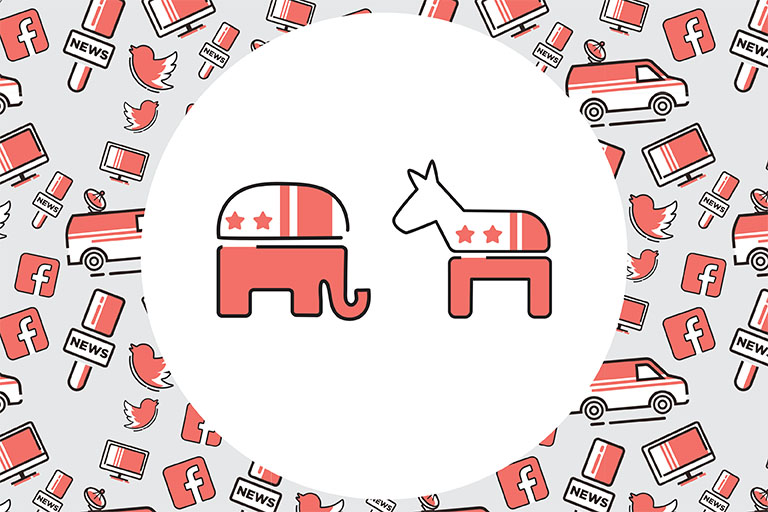There’s no doubt about it — social media has fundamentally changed the way we consume, share and process news. For Esther Thorson, a professor in the School of Journalism, understanding this phenomenon is vital.
Fake news often goes viral through social channels and has become a buzzword that researchers are still working to understand. Candidates share their political ideologies over social media and earn thousands of retweets and shares. As Thorson’s study of the last presidential election revealed, social media-based promotion was just as effective at promoting the candidates as traditional TV advertising — at a fraction of the price.
Political Advertising and the 2016 Presidential Election
Thorson and a group of her colleagues who once taught or studied at the University of Wisconsin-Madison have been studying news election coverage for eight years. Their informal research group has conducted large national studies centered around political socialization, the study of how people learn about, become involved in and become opinionated about politics.
The team did a study about how traditional political advertising on TV is losing its impact on people who are turning to social media-based promotion. During the 2016 presidential election, the group studied 100 American adults every day for 56 days leading up to the election. By using the rolling cross section research method, the team was able to treat each sample the same in order to more accurately analyze trends, even though they studied a different group of people each day.
“In my last couple of papers, what I’ve asked is, ‘How did the fact that Clinton spent most of her money on television impact American audiences versus how much did social media affect the audiences for Trump?’” Thorson said. “As you recall, Trump spent a lot less money on TV advertising. One of the things I found out is there was just as much impact for Trump via his social media investment as there was for all of the TV advertising that Clinton ran. And this was in spite of the fact that there was $250 million spent on TV advertising — only one tenth of that was spent on social media promotions.”
The team also examined whether large news events during the election lowered the overall attention to political advertising. Thorson defined these events as the televised debates and sensational stories such as Clinton’s email scandal and Trump’s sexual assault allegations. They found that large news events heightened people’s attention to political advertising. Thorson’s next step will be to understand how that interaction between news events and advertising operates.
Voting Intention in the 2016 Presidential Election
Thorson is also interested in how large news events and individual voter demographics affect people’s perception of, preference for and intent to vote for a candidate. The team discovered that events did not affect partisan's liking or evaluation of a candidate. However, they did find that the events affected the moderates, who are known to be more vulnerable to news and advertising because their minds are not yet made up. While general opinions didn’t change, these events did seem to influence voting choices for both groups. People might still have liked a candidate despite their involvement in a scandal, but at the end of the day, they decided against going out and voting for that individual.
“Some pundits tell us that’s probably what happened,” Thorson said. “A lot of people that voted for Obama in 2012 just didn’t bother to vote for Clinton, whereas it was just the opposite for Trump. A lot of people did not even vote in the prior election, but they did vote for Trump in 2016.”
Analyzing Slanted Headlines Reveals Lazy Fact-Checking Methods
While many people believe they can easily identify false news headlines, Thorson and her colleagues demonstrated that this isn’t always the case. The team conducted research on fake news using fact-checking sites such as Politifact and Snopes, gathering a total of 16 headlines. Half of them were rated as false and half of them were rated as true by the sites. They also made sure that half were conservatively slanted and half were liberally slanted.
The headlines were presented to people as if they were from either conservative or liberal sources, such as Breitbart or The Washington Post. People were asked to identify if the headline was true or false and if it was slanted conservative or liberal. They were also asked how they would verify if the headline was true or false given a list of options that included checking Google, consulting friends and family, looking at other news sources or doing nothing.
“We wanted to see what makes people go out and find the truth — the answer is not much,” Thorson said. “People did very light verification activities. Despite the fact that Pew Research Center tells us that most Americans say they encounter fake news and can tell it is false and they’re not affected by it, they’re likely too sanguine for their own good. Our respondents were very poor at identifying the truth of those headlines, and they were very affected by slant and occasionally the source.”
A Home at MSU
Thorson and her daughter, Kjerstin Thorson, assistant professor of Advertising and Public Relations, have worked together for several years studying political socialization, advertising and news coverage. The pair applied to work at Michigan State in the spring of 2016. After living states away from one another for a number of years, they were both ready to begin a new chapter of their careers together. The mother and daughter duo were both brought on as faculty members the following fall.
“I had visited MSU several times over the years and was particularly impressed with the faculty — many of whom had already been great colleagues and friends for years,” said Thorson.
Thorson plans to continue analyzing and writing about her research. In the next few months, she hopes to revise some of her convention papers and submit to academic journals.
By Rianna N. Middleton
